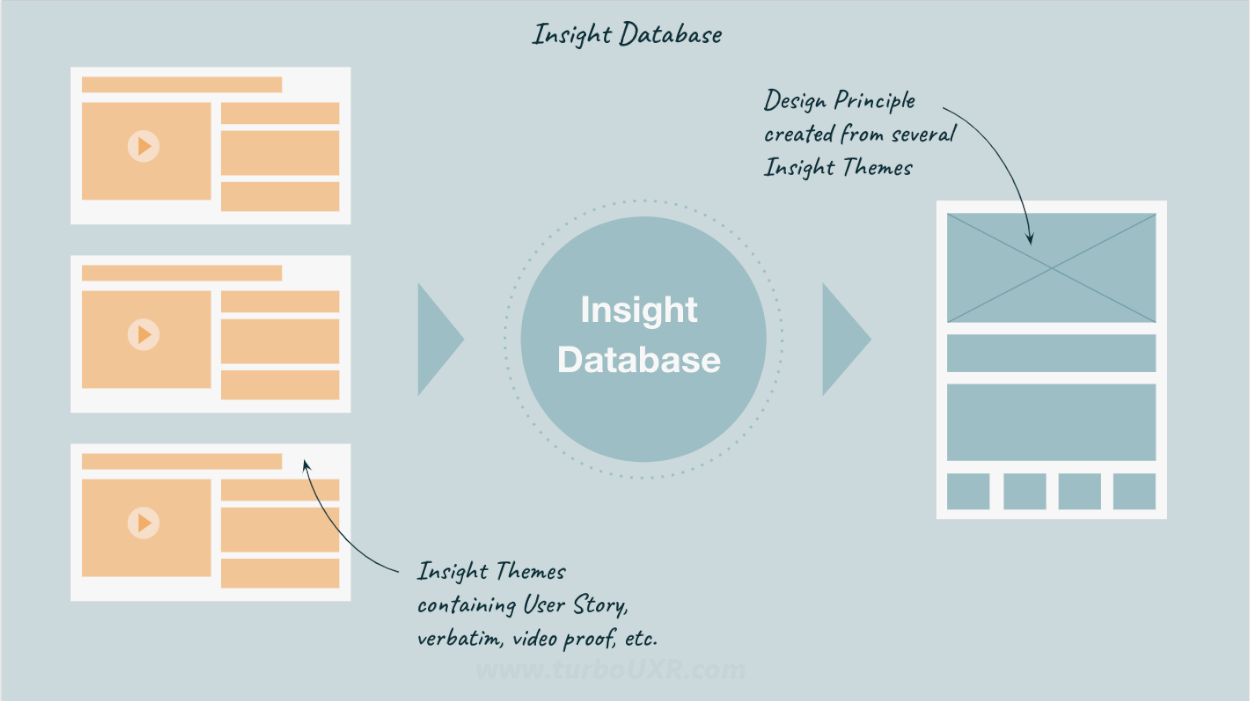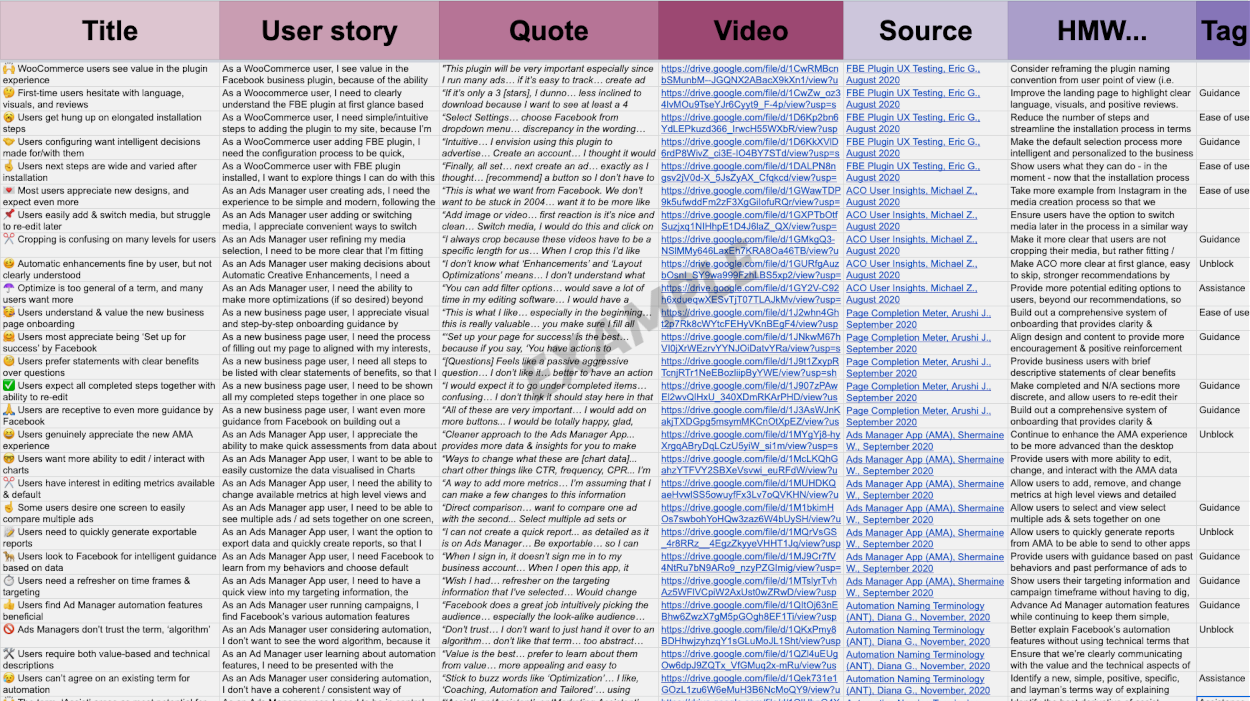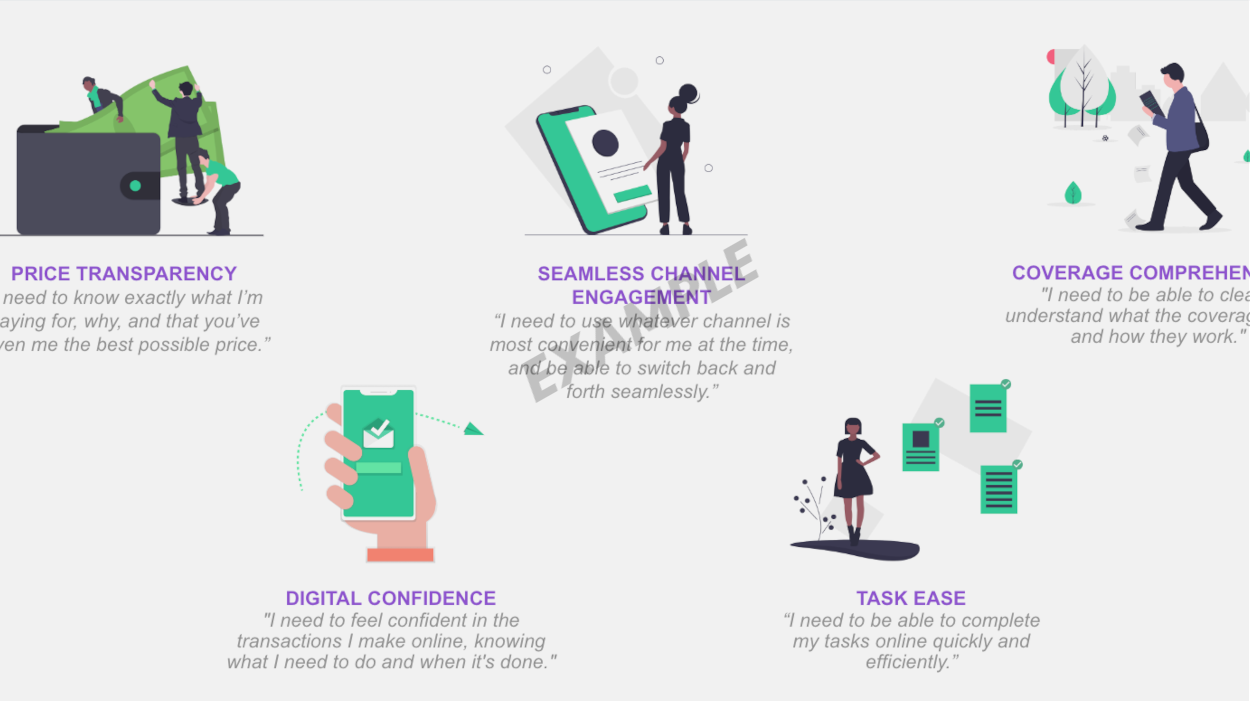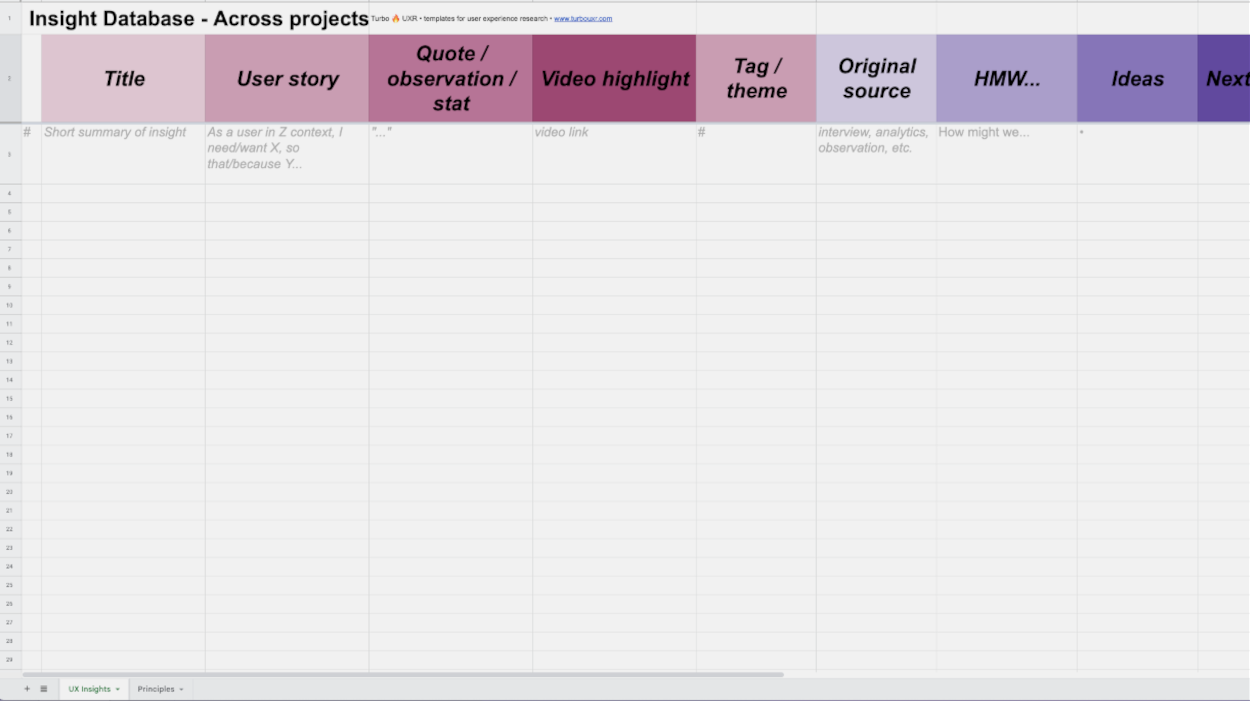Need user insights? Get the Playbook 📕
You're killing it. You've delivered countless projects in your UX research role. Untold number of recommendations implemented. You're driving quality improvements at a product-level user experience, across many touchpoints. Now what?
Work smarter, not harder.
The Turbo UXR Playbook is your tactical reference 👇 guide — free to download!
Get the Playbook
Learn More
If this is you, then you're in a good place to begin a UX research Insight Database. Until this point, you've mastered how to write user stories from UX research. You've made measurable improvements against key performance indicators with your approach to successful user insight storytelling. And you've gotten creative in ways to prioritize your UX recommendations, for maximum impact. You're definitely ready to take your UXR to the next level.
Throughout this article, we'll break down Insight Databases, and guide you in building up one of your own. We'll discuss what makes up an Insight Database, how one is made (with examples), we'll describe the value they provide (x4), and share a free template to make your own 😍. Read on to learn more and apply Insight Databases in your own user experience research practice.
Let's dive into the world of user experience Insight Databases.
research database data synthesis design principles uxr templates user insight themes research systems unmet user needs empathy building research process library jobs-to-be-done dovetail
Simply put, an Insight Database is a database of user insights.
A database itself is a repository of useful information, organized in an easily storable / searchable / gatherable manner. Databases can be built in Excel, SQL, MySQL, MS Access, Google Drive, and more. For our purposes, we're just talking about a straightforward Microsoft Excel spreadsheet or Google Sheets equivalent. Nothing too fancy here.

What makes a user insight? That's a more complicated question depending on whom you ask 😉. To us, an insight is a new piece of information that gives us a better understanding of the user, while providing an opportunity to do something about it. It's an a-ha! with an angle for the business to act upon.
A user insight has reached maturity when it's found significant evidence to support it. Several user insights that are similar, common, and/or share properties will be grouped into a user Insight Theme. Insight Themes are then summarized by a User Story, and accompanied by video evidence, succinct title, verbatim quotes, and actionable recommendations.
Therefore, an Insight Database is a place where you store user Insight Themes in order to make them searchable and organizable for later use.
We've come across both lean and mean variations of Insight Databases at different companies for which we've worked. We're here to show you that they can be robust and systematic process to bring value to your team, business, and user.
You don't have to spend millions 💰. In fact, you shouldn't. You just need discipline and a structured approach to documenting your work.
Insight Databases allow UX researchers to look across all completed UXR projects to ascertain insights at a meta level. They force you to think holistically. They allow you to identify unmet user needs. They give you a seat at the big girl/boy decision-making table, and more. Insight Databases represent an elevation of the UX research practice to a more strategic level.
OK, OK. Let me see some examples (you might be saying).
Work smarter, not harder.
The Turbo UXR Playbook is your tactical reference 👇 guide — free to download!
Get the Playbook
Learn More
Creating an Insight Database is easy. Continuing to use it — and have others consistently funnel their user Insight Themes into it — is the hard part.
Insight Databases are not terribly complicated. We suggest you start with a Google Sheets spreadsheet. They're sharable, editable by many, and have enough basic functionality for our purposes. All there is to an Insight Database is a series of columns: Insight Theme title, User Story, quote/fact/stat, evidence (video, photo, audio, etc.), original source, 'How might we...', and tag.
Now, you don't have to use our exact methodology. You're free to choose your own columns, that's just what's worked best for us over the years. If you do want ours as a starter, you can ⬇️ download our Insight Database template from our UXR templates article (see bottom of the section for link). Otherwise, you might choose / edit data columns to represent what's commonly included in your key deliverables.

As for the rows. Well, that's where your projects come in. Each completed UXR project might have outputs that fill up approximately 3–7 rows in the Insight Database. One row for every user Insight Theme. Check out our UXR templates article also, if you're curious about how to synthesize your data into compelling Insight Themes. The most important thing is to have consistent deliverable outputs. This insures the Insight Database runs smoothly 🍦.
The Insight Database then spits out meta themes known as Design Principles. Design Principles are Insight Themes at an even higher / more strategic level. By spit out, we mean you — as the UX researcher — perform analysis on the master data and formulate. The process is very similar to how you perform a project-level data analysis, only our data is rows of Insight Themes, amassed across individual UXR projects. And the synthesized output takes the form of Design Principles (again, with your skillful approach).
OK, great. We now have a living spreadsheet 🦎 of all your project outputs. We're using that to periodically generate 3–5 Design Principles, and the subsequent value they create (see 3 So-what's to Develop Design Principles to learn more).

One primary benefit of a UX research Insight Database is it forces you to think beyond any one individual project. To best make use of the database, we discussed that your outputs need to have consistency. That means you may have to simplify your UX research process; not go for broke with every project. Holistic view = standardized processes. In order to see the big picture 🌈, we need to have standard approaches to generating and documenting user Insight Themes.
We think of this standardization similar to good design 🖌️. Good designers and design systems impose a lot of repetition. Not everything is always 100% unique. It can't be. It won't look good or make sense. There are patterns, templates, libraries, guidelines, and yes creative flair, but within the guardrails of the chosen style. Modern design equates to design systems and standards.
A metaphor for the Design System is what you're building in the research realm. Let's call it a Research System. Since Insight Databases crave consistency, they force you to develop more cogent Research Systems (patterns, templates, libraries, guidelines, etc.) This is good for you. It's good for business.
Holistic thinking begets Research Systems. Badass 🤘.
Return to overview ⤴A huge benefit of the Insight Database is it allows you to identify unmet user needs. This is the gold standard for UX research. To uncover something genuinely insightful that no one else knew to look for, where to look, or how... this is what research is meant to do.
Insight Databases allow you to see between the cracks. Specifically, between the cracks of individual product experiences and respective touchpoints. When you start to examine normalized insight data across a wide breadth of products, experiences, and user touchpoints (thank you Research System!), you begin to pick up on important gaps and/or overlaps. You'll use your Design Principles to characterize these and bring them to life for others.

By seeing important UX gaps and overlaps (well-documented by your Design Principles) you're really seeing the end-to-end user experience from a more objective perspective. Like an end-user, you'll notice flaws, inconsistencies, and opportunities across all interactions.
Now, our Insight Database is acting like an expert user, with a UXR skillset.
Return to overview ⤴Your Design Principles will highlight major areas of UX opportunity that require business investment. There may be no product owner for the themes you pull together. In some cases, you can make a business pitch 💼, or partner with others whose job is to take it to the next level. Often, it's best to wait for opportunities to share with senior product leaders, design directors, CX management, etc. They'll let you know when they're looking for this type of strategic insight. Your job is to be prepared when the moment arrives.
Due to the drawn out time process, it can be difficult to see / feel traction. However, it's worth it to remain patient, positive, and persistent with the process. A time will come, when you are asked for your bigger/broader/badder perspective from the UX research team, and your Design Principles focused on meta user needs will shine 🌞.

As you build a reputation for a team that has this type of perspective into the product and experience, you'll be pulled into more situations that will value this input. Senior leaders will ask you for key insights, request you show up to certain planning meetings, and/or showcase your work on your behalf. It's amazing to see new initiatives spun up as a result of a well-oiled Insight Database ⚙️ and subsequent Design Principles. This is you earning a seat at the decision-making table.
A quick note about time commitment. We don't recommend spending an inordinate amount of time maintaining your Insight Database and related artifacts. Spend a few hours here and there over the quarter. Use perhaps 5–7% of your time, at most. Reason being, this is going above an beyond typical UXR project needs. You don't want take too much time / energy away from the UXR projects that keep the metaphorical lights on. Consider your Insight Database a backstage process for the most part.
Return to overview ⤴Some of the most appreciative recipients who've encountered the outputs of our Insight Database have been sister teams. Analytics, Marketing, Engineering, Design, Operations, and more typically have less interaction with the end-user of the business. Insight Databases offer a glimpse into the user's mindset and behaviors across a full spectrum of experiences.
These partner teams value knowing what the user is all about. They're also very equipped to to put the insights to work in their own field of application. Since Insight Databases span many types of products, users, etc., they offer a more holistic view into the end-user. We've found this instrumental in helping partner teams build empathy and understanding 💜.

Empathy building is a big part of UX research. Insight Databases can easily help others in the organization do the same. Sometimes it's the Design Principles you've created that strike a chord with internal stakeholders. Other times, they come to you looking / asking to dig for specific insights. Having a well-documented repository, with great "citations", helps you to quickly find insight into what they're requesting. When it's shareable like Google Sheets, you can simply point them there, and they can look themselves!
Lastly — we won't lie — overwhelming the occasional needy stakeholder with too much user data to digest (via Insight Databases) can be a useful way to punt 😉🏈.
Return to overview ⤴
In case you missed it! We've created a button below to download our Insight Database template (patent pending 😂). Feel free to use this in your process, team, company, whatev. We're just happy to share and add to the UXR community.
As always, reach out to us at Turbo UXR if you have an idea to improve. Or want to hash out some UXR related topics.
We're more than happy to chat 💬.
Get Insight Database template
Work smarter, not harder.
The Turbo UXR Playbook is your tactical reference 👇 guide — free to download!
Get the Playbook
Learn More